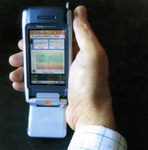Mobile phones a danger for ventilators, pacemakers in hospital rooms

Washington, Sept 6 : A research suggests that mobiles should be kept at least one meter away from hospital beds because they can cause electromagnetic interference (EMI) that may interrupt, obstruct, or otherwise degrade or limit the effective performance of critical care equipment.
Scientists verified that electromagnetic interference (EMI) incidents from second and third generation mobile phones happened at a mere three-centimetre distance.
The Dutch research was published in the online open access journal, Critical Care.
Almost 50 EMI incidents were recorded when the research team examined the effects of General Packet Radio Service (GPRS) and Universal Mobile Telecommunications System (UMTS) signals on critical care equipment such as ventilators and pacemakers.
75 percent incidents were significant or hazardous. Hazardous incidents varied from a total switch off and restart of mechanical ventilator and complete stops without alarms in syringe pumps to incorrect pulsing by an external pacemaker.
The second generation (2.5G) GPRS signal caused the highest number of EMI incidents at over 60 percent whereas the third generation (3G) UMTS signal was responsible for just 13 percent. EMI incidents also occurred a greater distance with GPRS with a hazardous incident even at three meters.
While first generation mobile phones are used mainly for voice transmission, 2.5G and 3G phones enable Internet access, sending and receiving data. They entered the market, however, with little proof regarding their safe use in the medical environment.
Dr Erik van Lieshout, lead researcher from the Academic Medical Center, University of Amsterdam, said; "Our work has real implications for present hospital restrictions of mobile phone use in patient areas."
"It is unlikely that mobile phone induced EMI in hospitals will be eradicated in the near future so the one meter rule currently in place should continue, as it is relatively safe," commented Dr van Lieshout.(With Inputs from ANI)